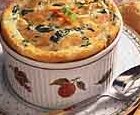|
French Entree
Spinach Souffle
Souffle aux Epinards
(Serves 6)
Souffles are ambrosia, foods for the gods! They're not as difficult as you might believe—and you can do most of the work ahead of time.
1 pkg. frozen chopped spinach
3 shallots or 1 small onion (minced)
T lemon juice
6 T butter (divided)
6 T flour
1 C milk
1/2 C light cream
1/4 tsp. pepper
6 egg yolks
4 T Parmesan cheese (grated)
7 egg whites (beaten till stiff)
Spinach: thaw spinach, drain, and squeeze out excess liquid. Set aside. In a skillet, melt 1T butter and sauté shallots or onion 3 minutes. Add spinach and lemon juice, stirring to break up spinach and coat with butter. Cook 5-10 more minutes, making sure all liquid is evaporated. Set aside.
Roux: in a medium saucepan, make a roux (see sidebar) with butter and flour. Very slowly, add milk and cream, stirring constantly to blend into thick creamy sauce. Remove from heat, cool slightly, and add yolks, one at a time, stirring vigorously. Stir in Parmesan cheese and add spinach mixture to eggs. Set aside.*
Assembly: preheat oven to 400. Grease a 2 qt. soufflé dish. Beat egg whites till stiff (they should form peaks). Very gently, fold beaten whites into spinach-cheese mix (this is what give the soufflé its light, puffy quality).
Bake: pour mixture into greased soufflé dish and place in oven. Turn the heat down, immediately, to 375 and bake soufflé 35-40 minutes, till top is puffed up and golden brown.
Serve PRONTO! with a salad and crusty French bread.
* You can make the souffle ahead of time up to this point. Right before your guests come, just beat egg whites, fold them into the spinach/cheese mixture, and bake the soufflé. (I’ve even beaten the whites beforehand, then quickly fluffed them up a bit.)
| See more French recipes |
|
|
Tips & Glossary
Bouquet Garni: (boo-kay gar-nee) bundle of herbs tied together with string or wrapped in cheese cloth square; usually parsley, thyme, bay leaf, and peppercorns. Flavor is released during long cooking.Remove before serving.
Chervil: (sher-vil) related to parsley but has a delicate anise flavor. Long cooking kills flavor, so add at the last minute.
Cornichon (kor-nee-shon) teeny-tiny pickle, served with pates & smoked meats; found in specialty food stores.
Fines Herbes: (feen-airb) mix of finely chopped herbs: parsley, chives, tarragon, & chervil. Not as strong as a bouqet garni. Buy it at most grocery stores.
Fromage: (fra-mahj) Cheese! The French eat more than any nationality, 45 pounds per capita per year; and the country makes more cheeses than any other country, about 400.
The three great pedigreed French cheeses are:
• Brie (East of Paris)
• Camembert (Normandy)
• Roquefort (Southwest France, from sheep’s milk)
There are also wonderful lesser-known cheeses:
• Beaufort (Rhone Alps, hard, yellow Gruyere-type)
• Chevre (Loire Valley, soft, goat’s milk)
• Comte (Alps region, hard, yellow Gruyere-type)
• Emmental (Alps region, “Swiss” cheese with holes)
• Gruyere (hard, yellow cheese—originally French, now most is Swiss)
• Tomme (means “cheese”; soft, many varieties, all from skim milk)
Herbes de Provence (airb-duh-pro-vonce): mix of dried herbs, usually thyme, rosemary, marjoram, basil, & bay leaf Can be found at most grocery stores.
Mutarde: (moo-tard), mustard. Most famous:
• Dijon ( from the town in Burgundy)
• Meaux (from Meaux, east of Paris; whole-grained; made by Pommery).
Nicoise Olive: (nee-swaz- oh-leev) small, purplish-black olive with a mellow, nutty flavor; used primarily in Salade Nicoise. The Picholine variety is a green, medium-sized olive with a light, nutty flavor.
Roux: (roo) paste-like mix of melted butter and flour, into which liquid is gradually added. The basis of every classic French sauce.
Basic Roux: 1 part butter to 1 part flour. Melt butter and add flour, stirring vigorously, till it becomes a paste-like consistency. At this point, add slowly whatever liquid your recipe calls for
|
![]()
![]()